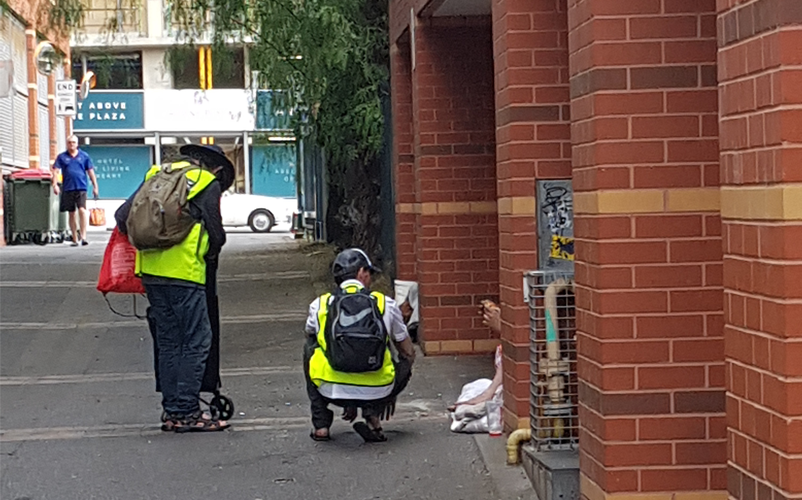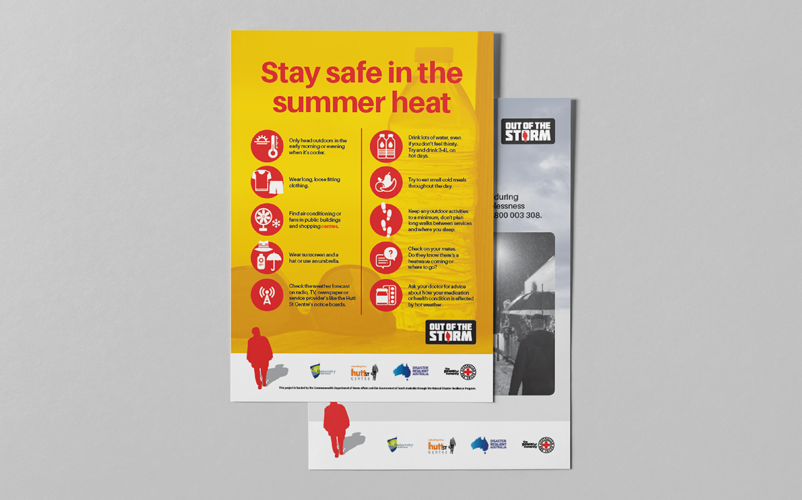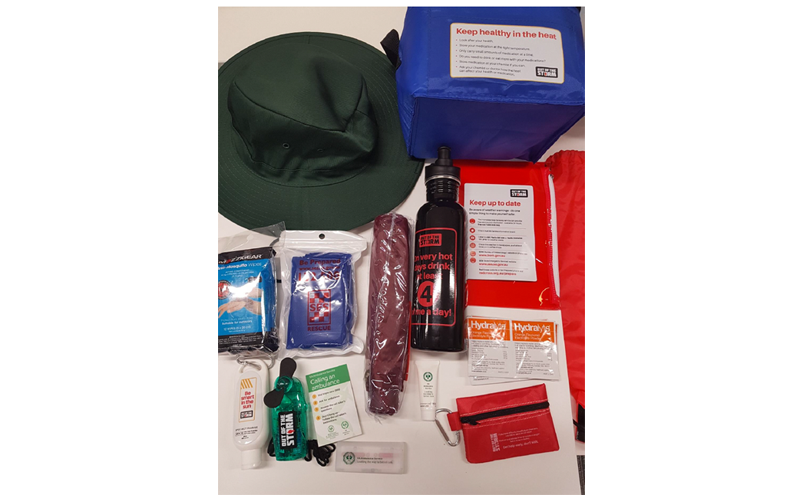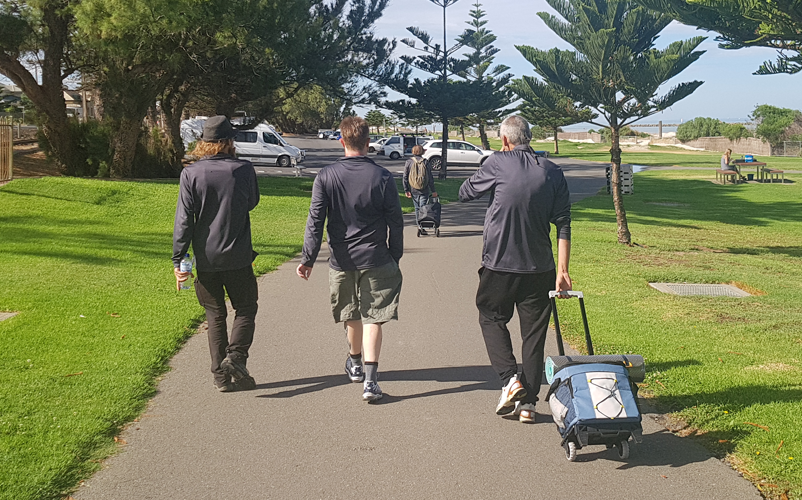This paper reports on the outcomes of a collaborative, strengths-based program developed to improve the preparedness of people experiencing homelessness during extreme weather in South Australia. The program, Out of the Storm, provided resources for dealing with heat, cold and storms that were co-designed by people experiencing homelessness, emergency services and health provider representatives and volunteer graphic designers. The program employed peer outreach workers who delivered 278 emergency kits and maps and who conducted 466 conversations about extreme weather with other people in experiencing homelessness in South Australia. This paper outlines the Out of the Storm program, including how principles of Trauma-Informed Extreme Weather Resilience Education were incorporated. This evaluation demonstrated that the Out of the Storm activities gave people access to relevant information and weather-protection items and built confidence, opportunities and social connections within the community and with emergency services organisations and health providers.
Research on extreme weather and homelessness
As the sun goes down and the storm clouds gather, people experiencing homelessness hunker down where they can with any supplies they may have to hand. People experiencing homelessness have developed skills to get through the vagaries of storms and hot and cold weather. However, such adaptation conceals a myriad of hardships, including isolation (walking to services becomes impossible with a 20 kg backpack in the heat), mosquito bites from sleeping outdoors, food that spoils and losing medication because it cannot be kept cool or dry (Cusack et al. 2013, VCOSS 2016). Severe weather like extreme cold, heatwaves, large storms, floods, cyclones and bushfires have even greater impacts on those in homeless communities. In 2017, an Australian study (Every, Richardson & Osborn 2019) found that:
- 39 per cent of people lost their home (tents, temporary structures, safe sleeping spaces) during severe weather
- 37 per cent experienced worsening or new mental health issues and of these, 30 per cent experienced trauma
- extreme weather was a factor in the pathway to homelessness for 16 per cent of people.
People experiencing homelessness are not well prepared physically or emotionally for protecting themselves from the economic, social and health effects of weather. They face significant challenges preparing for extreme weather, particularly social isolation, mental health issues and limited funds to purchase emergency supplies (Every, Richardson & Osborn 2019; Edgington 2009). Compounding these challenges are the gaps in access to preparedness resources. There is few specialised and targeted education materials about these risks, with 45 per cent of homeless services in Australia having no access to appropriate extreme weather hazards information (Every, Richardson & Osborn 2019).
Resilience education for homelessness communities
A multi-level approach of structured, educational and individual actions that can be taken is required to build resilience for people who are homeless. Education about extreme weather and how to cope helps to reduce inequality and exposure to risks as does providing housing and health care. Homelessness is a complex and systemic social issue, and extreme weather education is effective when it is embedded within, and builds upon, current intervention models used in homelessness prevention and support. Use of trauma-informed care offers is one approach for the provision of hazard resilience education (OASPR 2012). It emphasises agency, autonomy and respect, non-hierarchical relationships and an individual and systems focus on avoiding re-traumatisation (Mental Health Coordinating Council 2017, Jennings 2004). Trauma-informed care is a lens through which to understand the experiences and needs of people in homeless communities as well as specific challenges people face during extreme weather events (VCOSS 2016). Using this base, Every and Richardson (2018) developed principles of Trauma-Informed Extreme Weather Resilience Education with people experiencing homelessness. Table 1 summarises these principles.
The Out of the Storm program put the principles of Trauma-Informed Extreme Weather Resilience Education into practice. The program allowed for an evaluation of effectiveness in helping people understand their risks and potential actions to take.
Putting the principles into practice
The Out of the Storm program was a collaborative response to improve resilience to extreme weather events within homeless communities in Adelaide, South Australia. The project brought together people experiencing homelessness with local emergency services organisations and health providers to identify and develop appropriate information and materials that help people stay safe in cold, stormy or hot weather. People with a lived experience of homelessness (‘peer workers’) assisted by distributing this information and resources to other people experiencing homelessness in the Adelaide city area and surrounding suburbs. The objectives were to improve people’s knowledge about extreme weather hazards and what they can do, provide good material resources and social connections as well as potential employment opportunities.
Co-design: dialogues and knowers and makers sessions
Prior to the winter and the summer of 2018–19, the Hutt St Centre, an Adelaide homeless service provider, and the Australian Red Cross held facilitated discussions on extreme weather possibilities ahead. Building on an initiative of extreme weather dialogues used in the United States of America, (National Health Coalition to End Homelessness 2017) current clients of the Hutt St Centre spoke about exposure to cold, storms and hot weather with emergency services and health provider representatives from the SA SES, Red Cross and SA Ambulance Service. Eleven people experiencing various forms of homelessness attended the winter dialogue sessions and 21 attended the summer dialogues. The participants were aged between 35 and 55 years. Only two women attended in winter, one frequently. This improved in summer with four women attending, however, the majority of people who attended were men. The people who attended the sessions were ‘rough sleepers’ and included a mix of people who were more confident in sleeping rough and those less confident.

People experiencing homelessness hunker down where they can. Out of the Storm workers provided personal contacts and access to information and supplies.
Image: Alana Pedler
Table 1: Trauma-Informed Extreme Weather Resilience Education principles and implementation.
| Principles | Implementation |
| Build safe relationships | Employ trusted people, including peers, to deliver extreme weather information. Build relationships with emergency services organisations. |
| Co-create, collaborate and partner Strengths-based |
Resources reflect the shared knowledge of the homeless community and emergency services organisations. Activities that assist people to identify, develop and use skills and knowledge to respond appropriately during extreme weather events. |
| Empowerment | Develop plans and improve skills in relation to specific needs and specific hazards including knowledge of first-aid. |
| Provide essential material resources Be inclusive, non-discriminatory and non-judgemental |
Distribute weather-protection items via emergency kits like beanies, water bottles, sunscreen, mosquito repellant and tarpaulins to address the ongoing effects of poverty on people’s ability to respond safely. Acknowledge gender, age, sexuality, ethnicity, literacy standards and living circumstances that influence people’s ability to prepare, respond and recover from extreme events. |
The dialogue sessions promoted a relaxed atmosphere. The aim was for participants to work together to build knowledge about:
- access to messages about extreme weather events
- safe places when conditions are cold, wet or hot
- practical suggestions to keep warm and dry in winter and cool in summer
- resources available for extreme weather
- health concerns during extreme weather and what can be done
- assistance during extreme weather events.
The dialogues drew on the experiences and knowledge of people in the homeless community. These people shared their on-the-ground knowledge of the local area and showed innovative and practical skills for staying warm and dry in winter and cool in summer. They also explained how they support and assist each other during difficult times.
The dialogues were followed by four ‘knowers and makers’ creative workshops. In the workshops, between one and six people who had attended the dialogues worked with graphic designers who volunteered to transform the information into posters, an extreme weather guide map and summer and winter emergency kits. For example, based on the dialogue with the SA Ambulance Service, people attending the knowers and makers sessions developed the message ‘Drink 4 of me each day’ to be printed on water bottles.
The dialogue sessions informed what to put in the emergency packs. In the summer, people talked about being bitten by mosquitoes and needing a lot of sunscreen to use when outside. This led to insect repellent wipes (which are more transportable) being included in the kits and a refillable sunscreen scheme was adopted. In winter, people shared how difficult it was to stay warm. This led to handwarmers and a thermos being included in the kits.
Co-designed resources
Three resources for extreme weather resilience were developed through the dialogues and the knowers and makers sessions. These were posters, a local map and emergency kits.
Posters were displayed at homeless service provider locations throughout Adelaide. Posters included tips for staying warm and dry in winter and cool in summer as well as contact details for weather information and homeless support services.

Figure 1: Posters covered tips on what to do during times of extreme weather.
Extreme weather guide maps of the city were distributed to people experiencing homelessness through homeless service providers and through peer outreach activities. The maps showed:
- flood-prone areas
- cool places to stay in hot weather
- accessible water fountains
- public toilets
- free bus routes
- free electronic device charging stations
- doctors who bulk bill
- areas of free wifi coverage
- contact details for homeless service providers including place to eat, shower and find accommodation
- weather information sources
- extreme weather safety messages (e.g. places to avoid in storms and staying in contact with friends).
Emergency preparedness kits were put together by people with a lived experience of homelessness who were employed as part of the project. The kits were distributed through peer outreach activities. The kits included items to help people experiencing homelessness deal better with extreme weather conditions.
Peer delivery: the peer outreach program
The Out of the Storm program employed nine peer outreach workers (people with a lived experience of homelessness); four in winter and five in summer. Employing people with a lived experience of homelessness contributed to the project’s principles and its success. The aim was to facilitate people’s preparedness by drawing on peer’s existing knowledge and the relationships they had with people in the community:
A lot of people I know from [my time on the streets] so that helped a lot. From [that experience] I know how to deal with people and when to talk to people, when not to talk to people.
(Peer worker)
The peer outreach workers went out in teams of two for three hours a day between one and three days a week. In winter, outreach was conducted during June and July 2018 and in summer from November 2018 to the end of February 2019.
As well as distributing the emergency kits, the peer outreach workers spread the word about responding to extreme weather. The talking points they used were developed during the program’s discussions and creative sessions. Peer outreach workers could explain:
- the contents of the emergency kit, particularly things that might be unfamiliar to people (e.g. how to use the hand warmers, how to use the cool cloth and when to take the hydrolytes)
- the map, including places for warm meals and blankets in winter and cool places and water in summer
- the Code Red and Code Blue meanings (South Australian Government response to extreme weather during which some services stay open longer or overnight)
- how to contact homelessness service providers
- health safety, for example signs of heat stroke, staying safe in cars during hot weather and avoiding trees during storms.
Evaluating the project
The outcomes of the dialogues, creative sessions and peer outreach were evaluated against the project aims of increasing people’s preparedness, social capital and empowerment.
Data collection and method
The data for the evaluation were collected during participatory observation and interviews and through peer outreach worker engagement-tracking lists. Observations were conducted at each of the dialogues and creative sessions, at a kit-making session and during the winter and summer training sessions. This totalled approximately 30 hours. Data were also collected through 38 interviews with project staff (the Red Cross project officer and Hutt St Centre staff (11)), speakers and presenters at the dialogue and knowers and makers sessions (5), agencies that displayed the posters (2) and participants, peer workers and end users (17). Qualitative data were also collected at two group discussions with peer outreach workers in November and December 2019. The engagement-tracking checklists were completed by the peer workers in the field. These checklists recorded information on gender, approximate age of the person and the location of the interaction, brief details of what the peer worker provided to the person and what they talked about.

Figure 2: The Summer Extreme Weather Emergency Kit.
Hat, water bottle, refillable sunscreen container, small handheld motorised fan, SES cool cloth, first-aid kit, cooler bag, hydrolytes sachets, insect repellent wipes, umbrella, PVC document holder, SA Ambulance Service band-aid kit and sunscreen, SA Ambulance Service ‘Call an Ambulance’ card, city guide map.

Figure 3: The Winter Extreme Weather Emergency Kit.
Beanie, thermos, 2 x ten-hour hand warmers, wind-up torch, rain poncho, first-aid kit, dry bag, PVC document holder, carabiner clips for attaching items to backpacks, waterproof backpack cover, city guide map.
Findings
The Out of the Storm program successfully increased the reach of information of extreme weather events to people in the homeless community of Adelaide. Relevant information about extreme weather was provided directly to people via the information posters and through the conversations with the peer workers. Peer outreach workers documented 466 conversations about extreme weather with people experiencing homelessness and this format was a vital contribution to the positive evaluation of the project.

The Out of the Storm program employed peer outreach workers to distribute emergency kits and spread the word about responding to extreme weather.
Image: Alana Pedler
Direct peer communication helped reach people who may not always interact with community services:
Some people are reluctant at first to talk to you, but as time goes on, they see you ‘round a little bit, they see that you are trying to do some good and trying to help and it changes their way of interacting with you.
(Peer worker)
The emergency kits provided essential items to help physical preparedness. The peer outreach workers distributed 278 emergency kits. The response to the emergency kits was overwhelmingly positive:
I can use everything in here. I really needed one of these [the beanie].
(Person receiving an emergency kit)
People loved it [peer outreach and the winter emergency kits]. They really appreciated it because it was free and it was very helpful.
(Peer worker)
The co-designed map of the Adelaide CBD was particularly useful for people new to Adelaide. One peer worker noted:
[He] wasn’t interested in the kit themselves but loved the idea, living in a car; came back to Adelaide hoping for work, took a photo of the map and wanted information where to shower.
(Peer worker)
The peer outreach also addressed some gaps in warnings about extreme weather and weather information by improving the timeliness and reach of messages. The dialogues highlighted that extreme weather information distributed via mainstream channels was not consistently reaching people who were homeless. However, through the peer outreach activities, information was available to people at the right time:
The notifications through winter were pretty good. The [Out of the Storm] crew cruising around were good. They started notifying people; they were talking to them everyday, letting them know if it was going to get worse, giving them equipment.
(Person receiving an emergency kit)
The Out of the Storm program also facilitated new social connections that enabled enhanced resilience of people in the homeless community. The program’s training and employment provided those involved with a sense of confidence and participation in the community:
The biggest benefit that we’ve had in terms of the clients has been increased participation and engagement in the community and what confidence that brings. That’s expressed in all different ways. You’ve got some people who just naturally fit the role really well and you’ve got other people who started off quite shy and this has been a great opportunity to build communication skills.
(Homeless service provider staff)
The peer outreach fostered a sense of people being cared for and that there were trusted people to speak with. As the confidence of peer workers grew, they became more involved in how they could make a difference in people’s lives:
There was a woman sitting at the bus station (she’d been there four days) and she had no idea; someone robbed her for her last two dollars and she had no idea what to do so [we] went back [to Hutt St Centre] and we got some things happening for her. There were a couple of other things where we could go the extra mile.
(Peer worker)
The growing confidence of peer workers had effects beyond the program. It altered how people saw themselves and their place in the world:
I knew I wanted to continue doing something. I’ve always wanted to do something, and this is gonna be my path in life. I can use all the shit that’s happened and turn it into something positive, which is what I’ve always wanted to do. My family see me in a different light now. They see me as someone who’s actually trying to do some things with their life.
(Peer worker)
As well as new relationships within the community and peer worker social networks, the Out of the Storm program also created relationships between people experiencing homelessness and the program developers – Australian Red Cross, the SES and the SA Ambulance Service as well as with the graphic design volunteers. The knowledge gained through the program has been fed back into preparedness operations:
From an emergency services perspective, being invited to come along and meet people is absolutely fantastic. It’s great because we know that people are out there and we guess at how they might receive information or the actions they do or they don’t take; what’s available and what’s not available, so it’s absolutely priceless. I feed this information back into our operations section, the people who do warnings and also people who research our messaging. It’s an excellent way for us to ground truth with a group that we look at as being really high risk.
(Session contributor)


